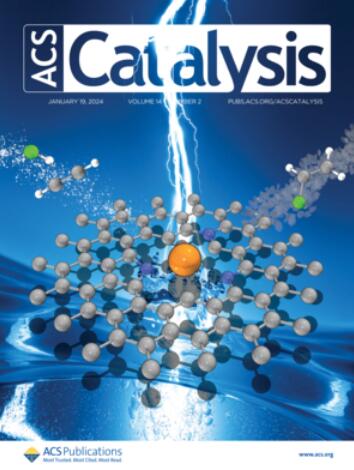Electrochemical Ammonia Oxidation Catalyzed by a Ruthenium Complex with a Dangling Sulfonate Group
IF 11.3
1区 化学
Q1 CHEMISTRY, PHYSICAL
引用次数: 0
Abstract
The goal of realizing a direct ammonia fuel cell and using ammonia as a hydrogen carrier motivates the development of electrocatalysts for the oxidation of ammonia to nitrogen. Herein, we report [Ru(bds)(4-methylpyridine)2] (Ru-bds-Mepy, bds = 2,2′-bipyridine-6,6′-disulfonate) as an efficient electrocatalyst for ammonia oxidation to nitrogen. The decent ammonia oxidation performance of Ru-bds-Mepy was demonstrated by cyclic voltammetry (kobs of 51.47 s–1) and bulk electrolysis (turnover number of 390). The hydrogen bond interaction between the coordination ammonia and the dangling sulfonate group was observed in the crystal structure and further demonstrated by density functional theory (DFT) calculations. Kinetic studies indicate that Ru-bds-Mepy exhibits first-order kinetics with respect to both catalyst and ammonia concentration. Then, DFT calculations suggest the potential of N–N bond formation via the nucleophilic attack of NH3 on the RuVI nitride complex in a barrierless and rapid way. This study contributes an efficient ammonia oxidation catalyst with a record-high turnover number.

悬空磺酸基钌配合物催化的电化学氨氧化反应
实现直接氨燃料电池和利用氨作为氢载体的目标激发了氨氧化制氮电催化剂的发展。本文报道了[Ru(bds)(4-甲基吡啶)2](Ru-bds- mepy, bds = 2,2 ' -联吡啶-6,6 ' -二磺酸盐)作为氨氧化制氮的高效电催化剂。循环伏安法(kobs为51.47 s-1)和本体电解法(周转数为390)证明Ru-bds-Mepy具有良好的氨氧化性能。在晶体结构中观察到配位氨与悬空磺酸基之间的氢键相互作用,并通过密度泛函理论(DFT)计算进一步证实。动力学研究表明,Ru-bds-Mepy在催化剂和氨浓度方面均表现为一级动力学。然后,DFT计算表明,通过NH3对RuVI氮化物配合物的亲核攻击,可以无障碍、快速地形成N-N键。本研究提供了一种高效的氨氧化催化剂,具有创纪录的高周转率。
本文章由计算机程序翻译,如有差异,请以英文原文为准。
求助全文
约1分钟内获得全文
求助全文
来源期刊

ACS Catalysis
CHEMISTRY, PHYSICAL-
CiteScore
20.80
自引率
6.20%
发文量
1253
审稿时长
1.5 months
期刊介绍:
ACS Catalysis is an esteemed journal that publishes original research in the fields of heterogeneous catalysis, molecular catalysis, and biocatalysis. It offers broad coverage across diverse areas such as life sciences, organometallics and synthesis, photochemistry and electrochemistry, drug discovery and synthesis, materials science, environmental protection, polymer discovery and synthesis, and energy and fuels.
The scope of the journal is to showcase innovative work in various aspects of catalysis. This includes new reactions and novel synthetic approaches utilizing known catalysts, the discovery or modification of new catalysts, elucidation of catalytic mechanisms through cutting-edge investigations, practical enhancements of existing processes, as well as conceptual advances in the field. Contributions to ACS Catalysis can encompass both experimental and theoretical research focused on catalytic molecules, macromolecules, and materials that exhibit catalytic turnover.
 求助内容:
求助内容: 应助结果提醒方式:
应助结果提醒方式:


